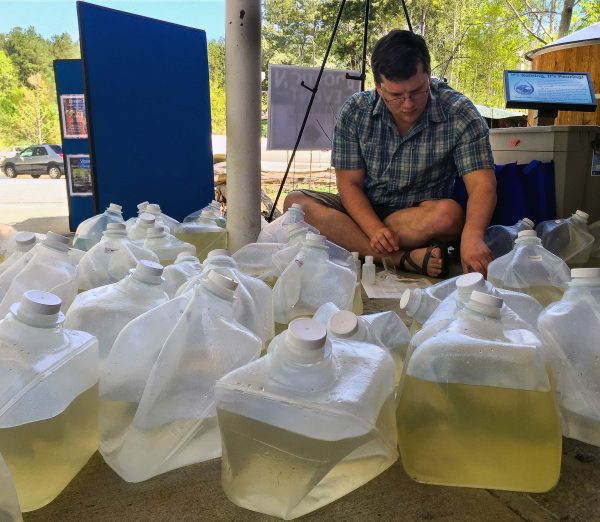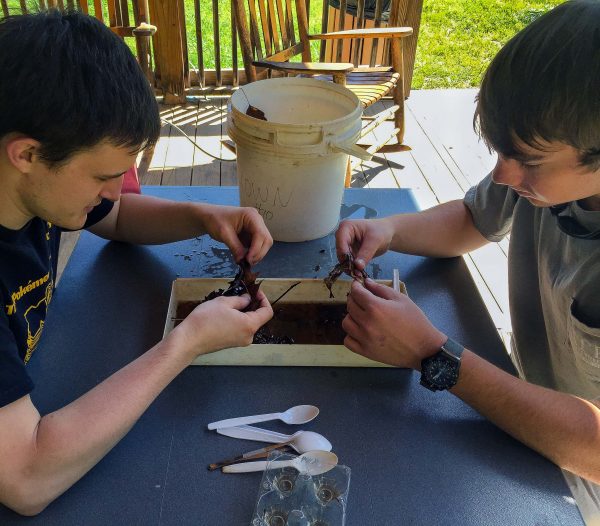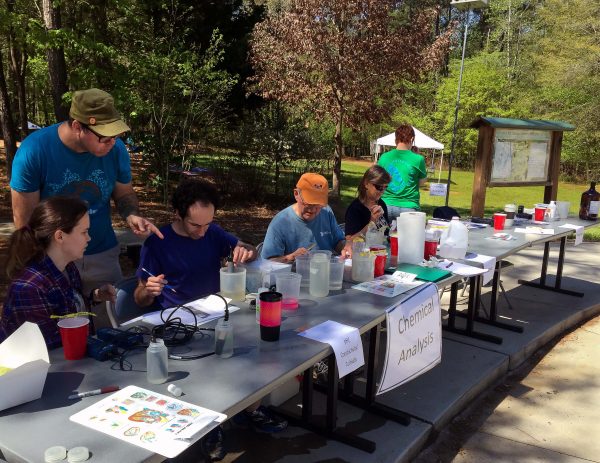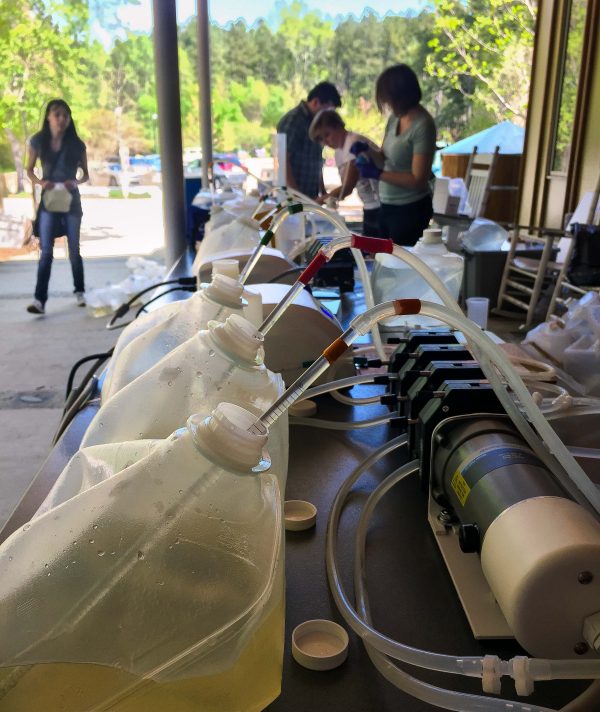Upper Oconee Watershed Network Celebrates 20 Years of Citizen Science

Working with water samples. (Credit: UOWN, via communication)
Recently, the Upper Oconee Watershed Network (UOWN) celebrated its 20th year of water sample collection and citizen science with the 2018 River Rendezvous. Hundreds of volunteers gathered for the event, confirming UOWN’s ongoing commitment to protecting water quality in local waterways. Cassidy Lord, UOWN’s vice president and a graduate student in the Warnell School of Forestry and Natural Resources at the University of Georgia (UGA), told EM about the program.
Citizen science watching the waterways
“The monitoring program came out of an Athens based group of concerned citizens in the late 1990s,” Lord describes. “They viewed the rapid development that was occurring across the county as detrimental to the natural environment and water quality. With this common goal, they created a monitoring system and, subsequently, an environmental non-profit called the Upper Oconee Watershed Network.”
Although the program remains similar in scope to its original iteration, the UOWN has become more focused in its water monitoring efforts. They’ve narrowed their sampling sites from about 200 to between 100 and 115, and have increased their collaborative efforts with their UGA research lab partners.

With this many participants, there are lots of samples to sort. (Credit: UOWN, via communication)
“UOWN has always analyzed for macroinvertebrates, pH, conductivity and turbidity,” explains Lord. “We are participating in a grant administered by the CDC with one of the labs that we collaborate with at the University of Georgia to assess water samples for the prevalence of antibiotic-resistant pathogens. This has allowed our analyses to expand to include fecal coliforms and enterococci. In recent years, we have started to cover nutrient measurements more regularly.”
In fact, thanks to collaborations with the UGA and the CDC, the UOWN program is among the most comprehensive citizen science projects focused on water quality in the country—and this is why the team has been so successful and has been able to expand their sampling as needed.
“We follow standard practices for collecting water quality samples and use YSI water testing sensors to measure specific conductance and pH,” details Lord. “We measure turbidity with portable meters and nitrate is analyzed using a Hach colorimeter. Volunteers wear gloves to collect samples in clean, sterile containers, and then bring the samples back to us where trained volunteers analyze the samples. We sample macroinvertebrates using the Georgia Adopt-A-Stream protocols. Samples are collected by sampling available habitats with a D-net or kick-seine. The leaf and limb debris is then picked through for macroinvertebrates which are identified to the taxonomic level of order or in some cases, family.”
UOWN’s data is available on their website to anyone that wants to use it for research or educational purposes.

Citizen scientists study sediment from samples. (Credit: UOWN, via communication)
“All we ask is that we’re notified of the data’s use and provided with a draft of the final product so we can see all of the innovative ways it is being used,” adds Lord. “We provide some of our data to the Georgia Adopt-A-Stream database. We are working on uploading our entire 20-year dataset sometime in the near future. We also assess the data to detect potential issues with pollution. In the case that we see something suspicious, we follow up with our contacts at Athens-Clarke County.”
Changing water quality, dedicated citizen scientists
The River Rendezvous takes place in Clarke County, home to the Middle Oconee and North Oconee river watersheds, and 15 others. Hundreds of volunteers assemble to gather samples throughout those watersheds, with some UGA graduate students beginning the chemical analysis there.
“The majority of our sites, which are located in urban areas, have seen a marked decline in water quality,” remarks Lord. “We are beginning to see deterioration in the outlying sites because of expanding development across the watershed. Large-scale grading and development has led to the expansion of impervious surfaces. We have seen a huge rise in stormwater runoff volume which is exacerbating erosion and sedimentation problems.”
The UOWN citizen scientists are well-prepared for their work.
“Our volunteers who are conducting the chemical, biological (macroinvertebrate) and bacterial analyses are typically certified by the Georgia Adopt-A-Stream program for citizen volunteer scientists or are students working in university labs that conduct such analyses,” explains Lord. “The bulk of our volunteers that come to the sampling events simply collect the water samples, which are then passed on to the aforementioned volunteers who conduct the actual measurements. We encourage our novice volunteers to become more involved and get certified. In fact, this happens all the time.”
Volunteers don’t need much equipment to do the sampling, and what they need, the UOWN provides.

Chemical analysis table at River Rendezvous. (Credit: UOWN, via communication)
“Because our volunteers mainly take water samples, we provide all of the equipment that they need,” details Lord. “We implement the buddy system for safety when collecting samples and our volunteers are given a brief training and safety presentation. They are provided with collection vessels, stream visual inspection forms, a thermometer, latex gloves and site packets with location directions.”
More experienced volunteers take on different roles, receiving the samples and analyzing them for the various parameters. The collection of macroinvertebrates, because it is more involved, also requires an experienced volunteer, who is responsible for proper collection and sorting of samples. Additionally, they calculate the scores and, when applicable, upload the data to the Georgia AAS database.
UOWN gets a high level of interest from local people who want to volunteer. For Lord and the UOWN team, this is attributable to a love for the area, an interest in recreational activities, a sense of stewardship and more.
“We are getting more interest from students at UGA via encouragement from their classroom instructors as well as a recent emphasis on experiential and community-based learning,” states Lord. “The protection of water and other natural resources resonates with our community members. Our organization believes that a sense of ownership can be developed through connecting with one’s local environment. Also, we think that it’s just a fun experience for adults and children alike.”

Some analysis takes place in the field. (Credit: UOWN, via communication)
The UOWN will continue to conduct their monitoring events and plan to develop new ways to reach community members.
“We are currently working on a project called ‘Where’s My Creek?’ that is designed to educate community members about the subwatershed they live in,” adds Lord. “There is so much that we can do to deepen the experience and connection between people and their environment. We also want to reach out beyond Athens-Clarke County to less urban areas in the upper Oconee River basin to protect our source watershed through sustainable conservation efforts.”
Two decades of success have solidified the UOWN’s name in the community, and that’s essential to maintaining volunteer involvement. The UOWN team hopes they can work with other organizations getting started in their own watersheds, so they can pass on their highly functional program design.
“After 20 years of water quality monitoring in northeast Georgia, we are extremely proud that we are still going strong with our work in the Upper Oconee watershed,” remarks Lord. “We recognize that our volunteers are the keystone to our success and we are incredibly grateful for all the support we have received from the generous citizens and businesses of our community. Our organization is operated by a completely volunteer board who dedicate their time, energy and weekends to conserving a resource that we are all equally dependent on—water.”
Top image: Working with water samples. (Credit: UOWN, via communication)




0 comments